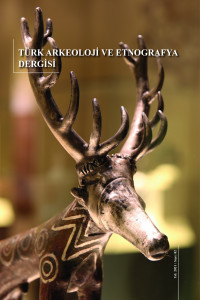TÜRK HAVA KURUMU GENEL BAŞKANLIK BİNASI TAYYARE CEMİYETİ GENEL MERKEZİ
- ISSN: 1302-9231
- Başlangıç: 1933
- Yayıncı: Kültür Varlıkları ve Müzeler Genel Müdürlüğü
2006 YILI ASSOS KAZI ÇALIŞMALARI
SIPYLOS MAGNESIASI ARKEOLOJİSİNE IŞIK TUTAN YENİ BULUNMUŞ BİR KABARTMA
BOYALIK NEKROPOLÜ 2007 YILI KURTARMA KAZISI
Hikmet DENİZLİ, Vahap KAYA, Nusret ÇETİN
TOROS TÜRKMENLERİNDE KEÇECİLİK
ÇANAKKALE İLİ, BAYRAMİÇ, EZlNE ve AYVACIK İLÇELERİNDEKİ BİZANS DÖNEMİ YERLEŞMELERİ
HASANKEYF ZEYNEL BEY TÜRBESİ MALZEME ANALİZLERİ ve KORUMA SORUNLARI
Bekir ESKİCİ, Ali Akın AKYOL, Yusuf Kağan KADIOĞLU
ALANYA KALESİ KAZILARINDA BULUNAN İNSAN İSKELET KALINTILARININ OSTEOLOJİK ANALİZİ
Handan ÜSTÜNDAĞ, F. Arzu DEMİREL
KIRKLARELI-DEMIRKÖY OSMANLI DÖKÜMHANESİ 2006 SEZONU ENDÜSTRİ ARKEOLOJİSİ KAZILARI ÖN RAPORU
H. H. Günhan DANIŞMAN, Fokke GERRITSEN, Mustafa KAÇAR, Hadi ÖZBAL, Rana ÖZBAL, Gülsün TANYELİ, Ünsal YALÇIN
